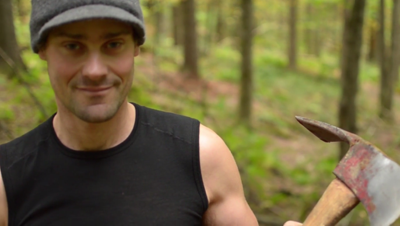Mountain bike trails have come a long way in the past 20 years.
Back then, trails were just that — narrow, heart-stopping, roughed-out routes through the forest.
These days, it’s not just the daredevils who ride mountain bikes. Kids, seniors, whole families ride mountain bikes.
Sure, you can still find gnarly root-and-rock features in the Stowe area’s mountain biking network, but the variety of trails has expanded tremendously to handle the growing participation in the sport, and the various ability levels.
Hardy Avery, founder of Morrisville-based Sustainable Trailworks LLC, knows more about that transition than just about anyone. In 12 years as the trail manager for the Stowe Mountain Bike Club, he designed a lot of the trails around here, finding smooth and fast routes through terrain so rough, it’s hard to imagine you’re actually on a bicycle.
Avery wants to build trails that people enjoy, that fit the New England environment, and that will last.
He started building trails as a kid growing up in Morristown, then worked at Chuck’s Bikes with his friend Dana Jourdan. They rode in their spare time, especially in Stowe, where mountain biking gained an early grip. Eventually, Avery and Jourdan opened their own bike shop in Waterbury, Irie Cycles. They quickly realized Waterbury had few options for mountain biking, “so we immediately started building trails in the Putnam Forest.”
Irie Cycles didn’t last, but the trail work did, and Avery grew with his sport. He wound up working with Tony Boone of Arrowhead Trails, a big-name trail designer, then came home to Vermont and founded Sustainable Trailworks in 2007.
Sustainable Trailworks took on its first big job in 2008 at Trapp Family Lodge, designing and building a 10-mile network of mountain bike trails. Next came a 3-mile intermediate trail network at Jay Peak, and then one job after another.
The key, he says, is protecting trails from water, which comes gushing down Vermont’s hillsides. Cuts in hillsides divert water and guide riders; huge stones are hauled to provide trail foundations. They say trails are cut, but they’re really engineered.
“And most of the time,” Avery says, “the path of least resistance is not the best path.”


(0) comments
Welcome to the discussion.
Log In
Keep it clean. Please avoid obscene, vulgar, lewd, racist or sexual language.
PLEASE TURN OFF YOUR CAPS LOCK.
Don't threaten. Threats of harming another person will not be tolerated.
Be truthful. Don't knowingly lie about anyone or anything.
Be nice. No racism, sexism or any sort of -ism that is degrading to another person.
Be proactive. Use the "Report" link on each comment to let us know of abusive posts.
Share with us. We'd love to hear eyewitness accounts, the history behind an article.